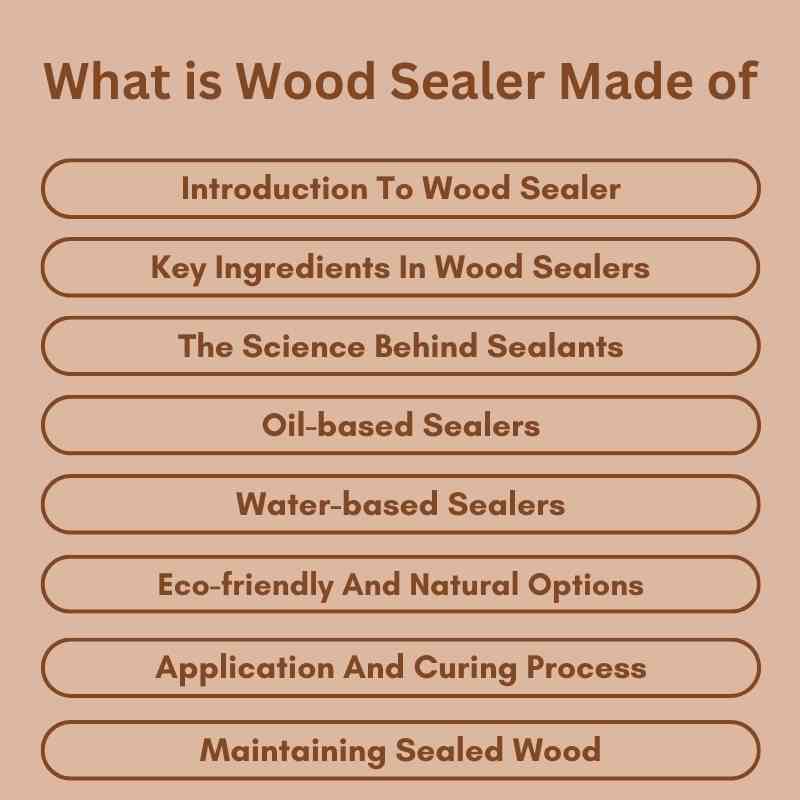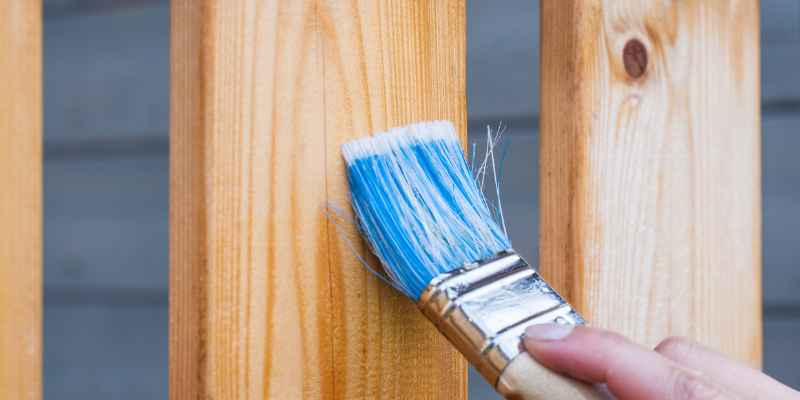Wood sealer is typically made from a combination of resins, solvents, and additives. These components work together to protect wood from moisture, UV damage, and wear.
Wood sealer plays a crucial role in maintaining the integrity of wooden surfaces. It creates a protective barrier that prevents water damage, rot, and mold growth. Various types of sealers are available, including oil-based, water-based, and polyurethane options. Each type offers unique benefits, catering to different wood types and usage scenarios.
Choosing the right sealer enhances the wood’s natural beauty while extending its lifespan. Regular application of wood sealer can significantly reduce maintenance efforts and costs. Understanding the composition and benefits of wood sealers can help you make informed decisions for your woodworking projects.
Introduction To Wood Sealer
Wood sealers protect wood from moisture and damage. They help maintain the wood’s natural beauty. Sealers create a barrier against dirt, stains, and UV rays. This protection extends the life of wood surfaces.
There are different types of wood sealers available. Some are water-based, while others are oil-based. Water-based sealers dry quickly and are easy to clean. Oil-based sealers penetrate deeper and offer strong protection.
| Type of Wood Sealer | Features |
|---|---|
| Water-Based | Fast drying, easy cleanup, less odor |
| Oil-Based | Long-lasting, deep penetration, more odor |
| Shellac | Natural, quick drying, not water-resistant |
| Varnish | Durable, high gloss, good UV protection |

Key Ingredients In Wood Sealers
Wood sealers contain solvents that help in mixing the ingredients. These solvents evaporate, allowing the sealer to dry quickly. Common solvents include water, alcohol, and mineral spirits. They are essential for application and penetration.
Another key component is resins. Resins create a protective layer on the wood. They help in forming a strong, durable finish. Film formers are also critical. They ensure the sealer forms a solid film over the wood surface. This film protects against moisture and damage.
| Ingredient Type | Examples | Function |
|---|---|---|
| Solvents | Water, Alcohol, Mineral Spirits | Mixing and drying |
| Resins | Polyurethane, Acrylic | Protective layer |
| Film Formers | Epoxy, Shellac | Solid film formation |
The Science Behind Sealants
Wood sealers are made from various chemical compounds. These include resins, solvents, and additives. Each component plays a vital role in protection.
Sealants create a barrier against moisture, preventing wood from warping and cracking. They also protect against UV rays that can fade wood colors. This helps maintain the beauty of wood for a longer time.
Different sealers have unique properties. Some dry quickly, while others take more time. Choosing the right one depends on the project and wood type.
| Component | Function |
|---|---|
| Resins | Provide a hard protective layer |
| Solvents | Help in application and drying |
| Additives | Enhance durability and flexibility |
Oil-based Sealers
Oil-based sealers are popular for protecting wood surfaces. They provide a strong barrier against moisture and UV rays. Common oils used in these sealers include:
- Linseed oil: Known for its deep penetration and durability.
- Tung oil: Offers a strong water-resistant finish.
- Teak oil: Ideal for outdoor furniture, enhancing natural color.
These oils each have their own benefits and drawbacks. Linseed oil dries slowly but provides excellent protection. Tung oil dries faster but may need more coats. Teak oil is easy to apply but might require frequent reapplication.
Choosing the right oil-based sealer depends on your project’s needs. Consider the wood type and its exposure to elements.
Water-based Sealers
Water-based sealers are popular for their safety and ease of use. They contain acrylics and various polymers. These materials help create a protective layer on wood surfaces.
One major advantage of water-based sealers is their low odor. This makes them safe for indoor use. They dry quickly, allowing for faster project completion.
Water-based sealers are also environmentally friendly. They release fewer harmful chemicals into the air. This helps keep both people and pets safe.
Many people choose these sealers for their durability and flexibility. They offer long-lasting protection without damaging the wood.
Eco-friendly And Natural Options
Many people prefer eco-friendly options for wood sealers. Plant-based alternatives are becoming popular. These sealers use natural ingredients, reducing harm to the environment.
Some common plant-based options include soy, linseed oil, and beeswax. These materials offer good protection while being safe. They help keep wood looking beautiful without toxic chemicals.
The rise of green sealants shows a shift in consumer choices. More people want products that are safe for their families and the planet. Choosing natural sealers supports both health and sustainability.

Application And Curing Process
Applying a wood sealer correctly ensures the best results. Clean the surface thoroughly before application. Use a brush or roller for even coverage. Apply in thin layers to avoid drips. Allow the first coat to dry before applying a second one.
Check the weather conditions before starting. Ideal temperatures should be between 50°F and 90°F. Avoid high humidity, which can affect drying times. Always wear appropriate protective gear while sealing.
Understanding curing times is vital. Curing can take several days to complete. Full protection may not be achieved for up to two weeks. Follow the manufacturer’s recommendations for the best results.
Maintaining Sealed Wood
Maintaining sealed wood is easy with simple routine care tips. Regularly clean the surface with a soft cloth. Avoid using harsh chemicals that can damage the finish. For outdoor wood, check for signs of wear and fading.
Reapply sealer every one to three years. This depends on the wood type and climate. Look for signs of peeling or cracking. If water does not bead on the surface, it’s time to reseal. Always choose a high-quality sealer for the best results.
Frequently Asked Questions
What Ingredients Are In Wood Sealer?
Wood sealer typically contains resins, solvents, and additives. Resins provide adhesion and protection, while solvents help with application. Additives may enhance water resistance or UV protection. Together, these components ensure durability and longevity for wood surfaces, making them suitable for both indoor and outdoor use.
Is Wood Sealer Eco-friendly?
Many wood sealers now feature eco-friendly formulations. These products often use water-based solvents and natural resins. This reduces harmful emissions while maintaining effective protection for wood. Always check labels for certification to ensure environmental safety. Eco-friendly options are increasingly available to meet consumer demand.
How Does Wood Sealer Protect Wood?
Wood sealer creates a barrier against moisture and UV rays. This barrier helps prevent rot, warping, and fading. By sealing the wood, it also minimizes the risk of mold and mildew growth. Proper application enhances the wood’s appearance and extends its lifespan significantly.
Can I Make Wood Sealer At Home?
Yes, you can make a simple wood sealer at home. Common ingredients include beeswax, linseed oil, and turpentine. Melt the beeswax, then mix it with oils for a natural finish. This DIY sealer can protect wood surfaces but may not offer the same durability as commercial products.
Conclusion
Understanding what wood sealer is made of helps you choose the right product for your project. Different ingredients offer various benefits, from water resistance to UV protection. Always consider the specific needs of your wood surfaces. A good wood sealer enhances durability and appearance, ensuring your projects last for years.

